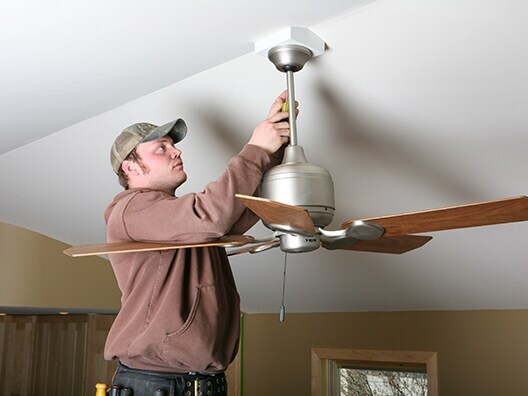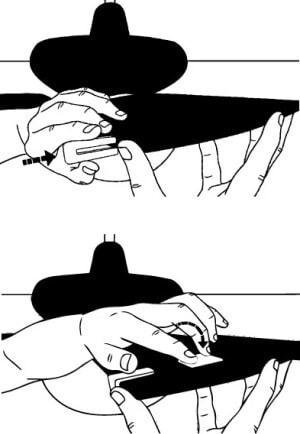How To Fix A Noisy Ceiling Fan
Posted on February 11, 2021 By Alison P
It's bedtime. You're in your favorite pajamas, you've let the dog back inside for the night, and you've plugged in the phones to charge. You remove all unnecessary pillows from sight, peel back the covers, and nestle in for a great night's sleep. You close your eyes and begin dozing off, until you hear a gentle creak creak creak that only gets louder. Your ceiling fan is being noisy again.
You'd turn it off, but you know the room would instantly get too stuffy to sleep. You grudgingly settle in, vowing that this will be the last night you toss and turn at the fan's mercy. If today is your day of action against ceiling fan noise, here are some methods for silencing your fan once and for all!
Common Reasons Your Ceiling Fan Is Making Noise
- Unbalanced Blades - Blades that are not balanced will create instability, which will cause ceiling fan wobble and noise. Imbalance is caused by blades of different weight, or by blades that have been bent. Upwardly-bent blades could also be hitting the fan's housing.
- Dimmer Switches - Dimmer switches were never created to be used with ceiling fans, though some households use dimmers to control fan speeds. This electrical setup can result in that dreaded humming noise.
- Loose or Damaged Mounting - The ceiling fan's mounting may be loose, or there may be another issue with the ceiling.
- Loose Fan Screws - Loose screws can impact both the mount and the blades.
- Low Voltage to Capacitors - When ceiling fans don't receive the proper voltage, capacitors can create a humming noise. This can be caused by multiple electronics or multiple rooms that are connected to the same breaker circuit.
- Unlubricated Motors - A ceiling fan motor that is no longer properly lubricated makes a squeaking or grinding noise.
- Misplaced Down Rod - The down rod is the bar that connects the fan to the ceiling. A loose or dirty down rod in the interior ceiling fan parts causes the ball that sits in the mounting bracket to make a clicking sound.
- Pull Chains - Chains can spin and end up hitting the ceiling fan housing.
- Loose Light Fixtures - Attached lighting fixtures may have come loose.
Easy Steps to Maintain Your Ceiling Fan
If you've identified your problem, there's usually a quick solution to get things up and running in top shape. If you're unsure of what the problem is, there are some steps you can take that may help.
- Clean Your Ceiling Fan - Start by cleaning your blades, where dust and grease can gather and make the blades unbalanced. Dust and wipe down light fixtures and mounting.
- Tighten All Screws - Tighten the screws on the blades, ceiling fan housing, mounting bracket, and light fixtures. Tightening screws will reduce most common ceiling fan noise.
- Check for Bent or Warped Blades
- Shorten the Pull Chain

Additional Ways to Fix a Loud Ceiling Fan
If you make these initial fixes but you're still dealing with a loud ceiling fan, there are other ways to find a cure for the creaking.
- Lubricate the Fan Motor - Use the correct lubrication method to reduce the squeaking sound.
- Replace Your Dimmer Switch - Connecting your fan to a regular switch may fix the problem.
- Use a Balancing Kit - If the blades are unbalanced, there are ceiling fan balancing kits that can help ensure that all blades are the same weight. Most ceiling fan kits include a balancing kit that has a blade balancing clip and several adhesive backed weights. Here's a quick rundown of how to use it:
- Start by sliding the balancing clip on the edge of one of the blades, halfway between the housing unit and the tip of the blade. Turn the fan on to check how the fan wobbles or creaks.
- Repeat by adding a clip to the next blade and continue to add clips, stopping to check how the fan's wobbling has reacted. Slide the clips away from the center of the blades to adjust wobbling and creaking as much as possible.
- Peel off the backing on the balancing weight and stick the weight on the top center of the blade directly in line with the clip. Add as much weight as needed to repair the fan.
When to Replace Your Ceiling Fan or Its Parts
If you've tried all of your other options to no avail, you may need to consider more costly options.
- Replace the Down Rod - If your issue is the down rod itself, you may need to purchase a new one.
- Replace the Fan - If you've exhausted your options, you may need a new fan. There could be issues with the capacitor that would require an expert to fix. It could be more cost effective to buy new.
Sometimes you just have to let something go to save yourself the time and money of working on something beyond repair, even if you've already put energy into trying to fix it. In that event, P.C. Richard & Son carries a wide variety of top quality ceiling fans at a flexible price range. Together, we'll get you sleeping soundly again!